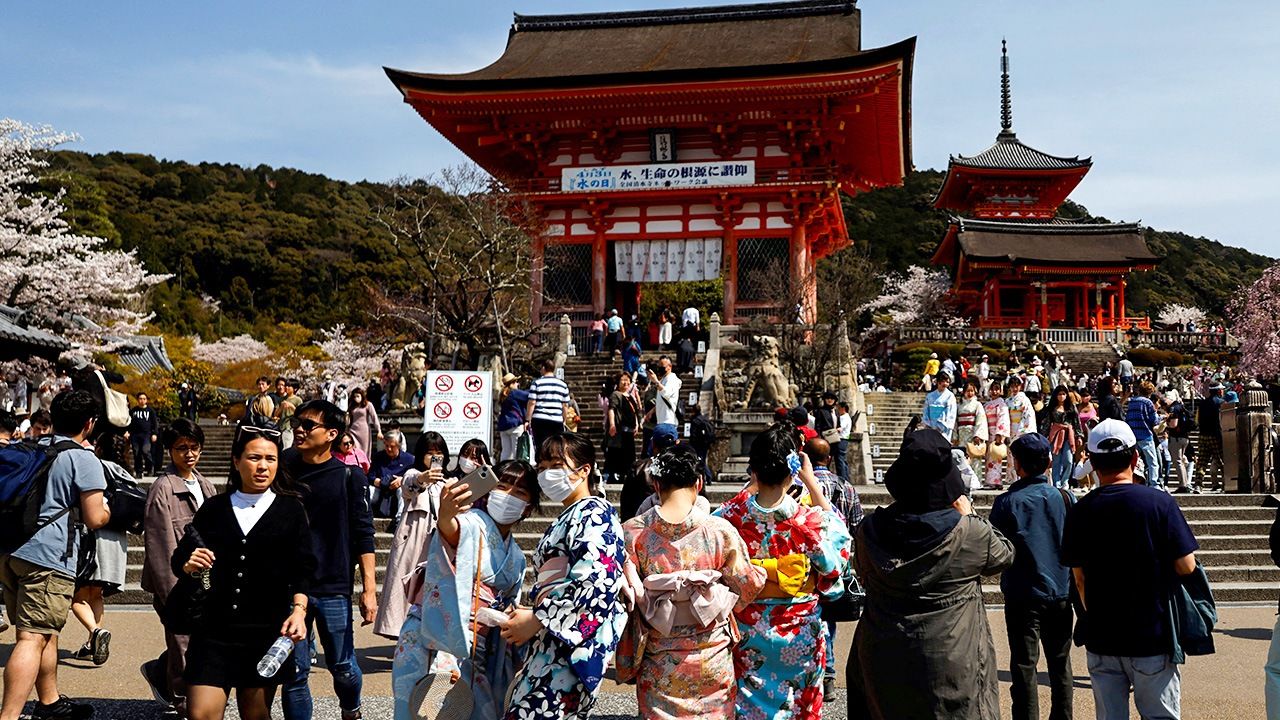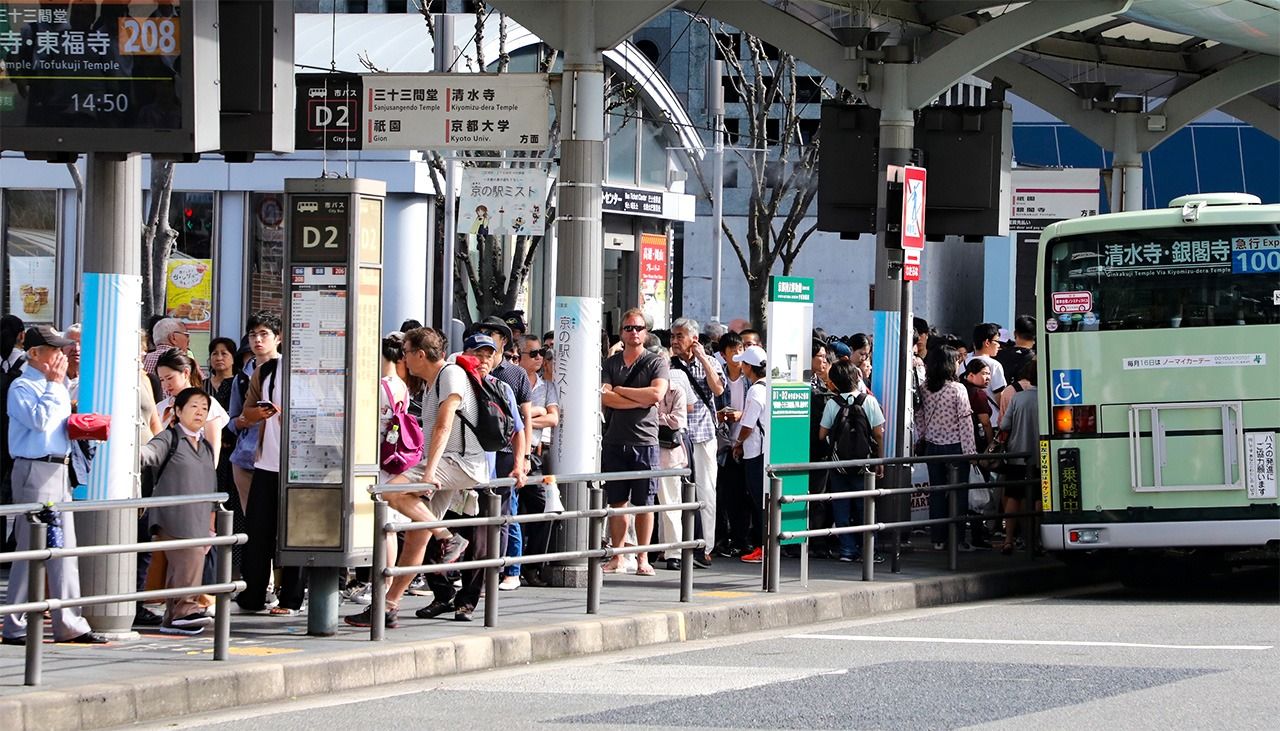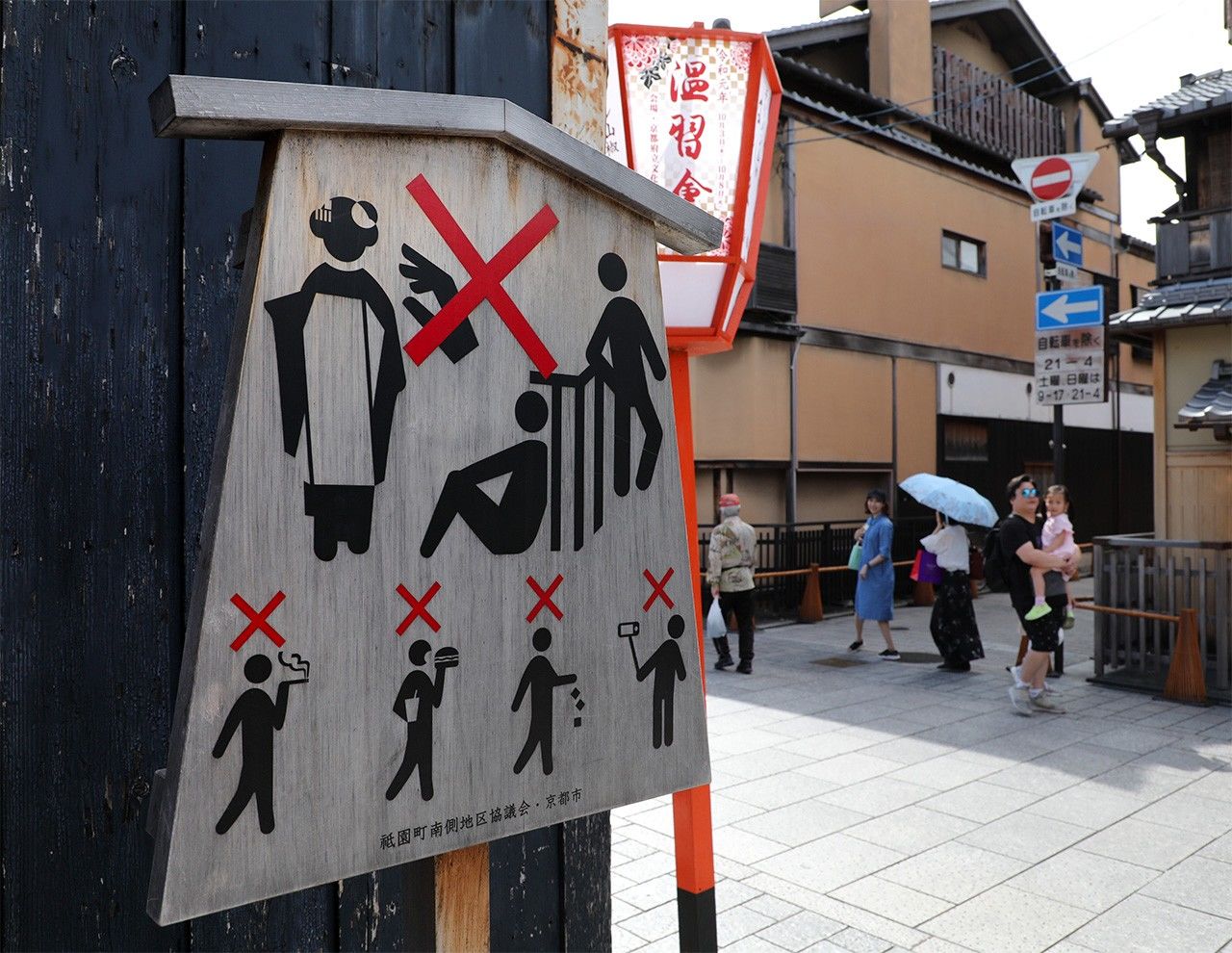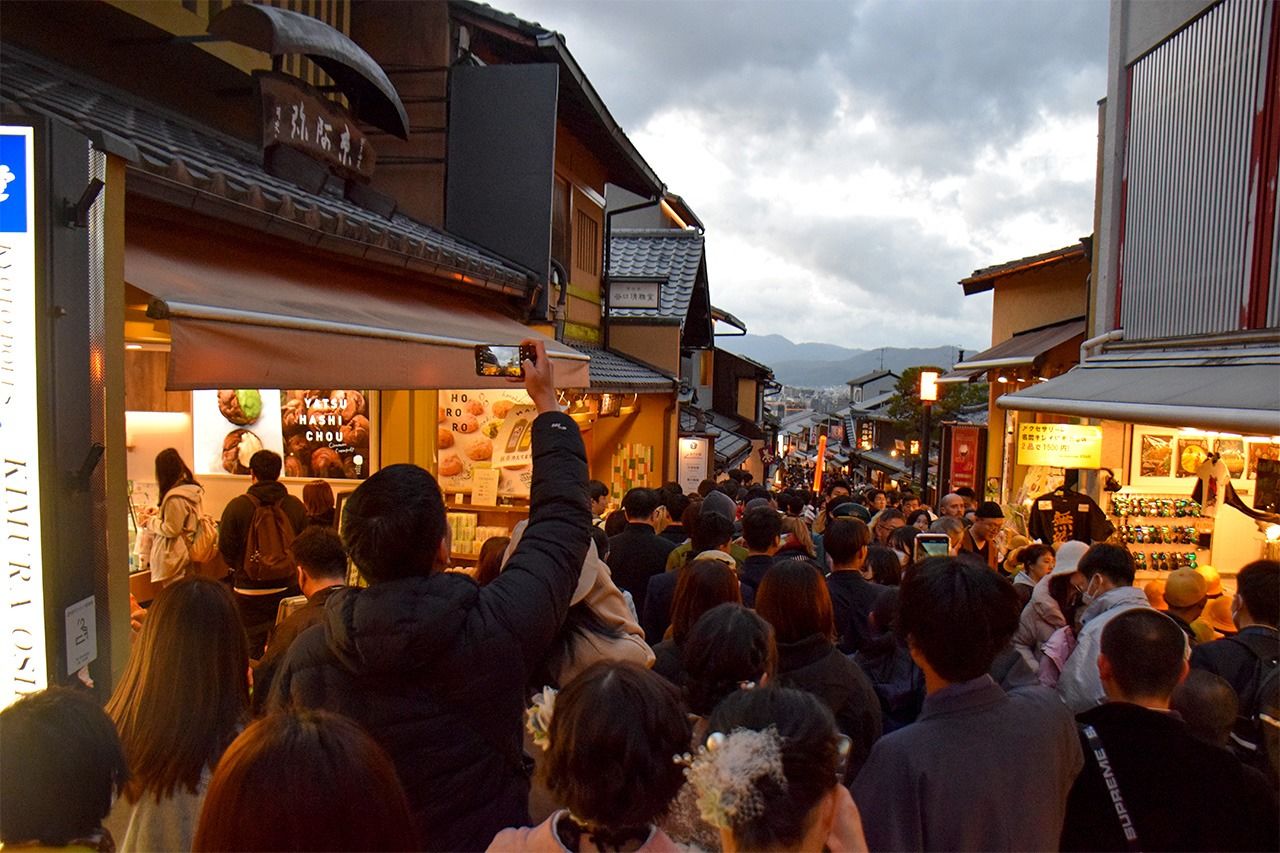
RPG in the Streets of Kyoto: A Fresh Strategy to Handle Overtourism
Society Travel Guide to Japan World- English
- 日本語
- 简体字
- 繁體字
- Français
- Español
- العربية
- Русский
Kyoto Hospitality is the Prize
Kyoto, Japan’s cultural capital, has attracted overseas tourists in considerable numbers since well before World War II. A famous example was the great comic actor and filmmaker Charlie Chaplin, who first visited the city in May 1936. He devoured 30 tempura prawns while in Tokyo, but in Kyoto, he applauded a chef deftly wielding his knife at fine dining restaurant Hamasaku in Kyoto’s Gion district. Chaplin was deeply aware of the food culture of each place he visited. He stayed at the renowned Hiiragiya ryokan, which he said paid attention to needs whose existence he was hitherto unaware of.
During his second visit, in 1961, as Kyoto shimmered in the rain, Chaplin compared its beauty with an ukiyo-e. He was intrigued by a public bath, where he bought ice creams for all the children. Chaplin had in fact used public baths in London in his childhood. The King of Comedy found similarities with his hometown even in distant Kyoto.
But that was over 60 years ago. Now, the boom in inbound visitors has led to clashes of interest caused by overtourism to Japan. Two key questions are being asked: how to restrict tourist numbers and counter “nuisance tourism,” and how to encourage visitors to spend more money. Is it possible to resolve these seemingly antithetical problems?
Full Buses, Littering, and Badgered Geiko
Kyoto is crying out for help! Each year, it receives some 50 million tourists, making Higashiyama and Arashiyama nearly impassable at peak seasons. Buses are at full capacity. Many visitors are ignorant of Japanese manners, and their litter fills the streets. Recently, footage of foreign tourists pursuing and badgering geiko sparked outrage. When I stopped to pray at a statue of Jizō (guardian deity of children), I was surrounded by tourists and photographed. What on earth did they think they were capturing?

Kyoto Station bus terminal teeming with tourists in Shimogyō Ward. (© Jiji)
In addition, Kyoto is seeing encroachment by more and more foreign-owned luxury hotels and tacky shops built with Tokyo money. Despite the significant impact and burden upon the locals, they receive little benefit.
The local government has taken countermeasures, such as boosting trash collection and running express buses to key tourist sites. Late in 2023, plans were announced for the construction of an above-ground concourse at Kyoto Station to alleviate congestion, at a cost of ¥19.5 billion. Efforts are being made to reduce overcrowding, by recommending lesser-known tourist sites, and temples and shrines promoting early morning visits. Still, these efforts fail to provide the radical solutions needed.
Resistance to a Tourist Tax and Two-Tier Pricing
Can countermeasures in other cities provide guidance?
This year the city of Venice, Italy, introduced an “access fee” for day visitors in peak periods. Himeji, in Hyōgo Prefecture, is debating hiking the entry fee to its UNESCO World Heritage–listed castle for overseas visitors.
But such measures would be difficult to apply in Kyoto. How would it be possible to impose a fee on people simply passing through and admiring the city? The conditions in Japan’s ancient capital are very unlike those of Venice, which has a limited number of entry points to the island, and Himeji, where most people travel for the castle alone. Indeed, even in Venice, it seems that the new fee has not helped to alleviate the crowds. Furthermore, a two-tier pricing system would surely damage Kyoto’s image.
The Living Industrial City is the Tourism Asset
We must consider the essence of Kyoto.
The tourism industry accounts for around 10% of Kyoto’s gross production. Although this is significantly higher than the national total of 2%, the largest industry in Kyoto is the manufacture of electrical and other equipment, contributing 20% of its overall income. Furthermore, Kyoto is an education capital, with many research institutions. Its temples and shrines also make it a religious capital.
Indeed, the people engaged in Kyoto’s industries and the activities of religious institutions are themselves the city’s tourism assets.
Tourists are excited when they spot real geiko (often referred to abroad as “geisha”) and maiko (apprentice geiko), women who have spent years of strict training honing their dance and music skills. Typically, they wear gorgeous kimono of Nishijin brocade (Nishijin-ori in Japanese), silk produced in the northwestern part of Kyoto City. Their other accoutrements are also mostly manufactured in Kyoto. But they are not here for tourists—they are in fact working.
Transforming Tourists from Onlookers into Participants
Kyoto’s tourism assets are living and breathing: the industries that make the city tick. This makes it difficult to define Kyoto’s appeal, but if visitors could grasp this, it might resolve many of the issues currently faced. Friction arises when someone intrudes who has no business there. The solution is to transform tourists from onlookers admiring Kyoto’s “past” into participants in today’s Kyoto.
But the threshold for entry into Kyoto life is high, and being a participant is no easy task, especially with the many unwritten rules. It would be ideal if tourists could enjoy the journey.
An RPG in the Streets of Kyoto
In my book Kyōto no onedan (The Price of Kyoto), I conceive of the city as the setting for a role-playing game. Learning its mysterious rules and gaining more experience makes it possible to progress in this RPG. If you meet a “boss,” you can enter a new world.
If foreign visitors pursuing maiko knew that these women, walking outside in full regalia, are on their way to work, they might realize it is wrong to bother them.

A sign to discourage problematic behavior by tourists toward maiko in Hanamikōji-dōri in Gion, Kyoto. (© Jiji)
There are other ways to see maiko for a reasonable price. One option is the beer garden open at Kamishichiken in summer, where you can enjoy beer and snacks in a garden setting while watching maiko and geiko rehearse their dances. If tourists gain more experience and encounter a “boss” character (perhaps the matron of a tea house, where patrons are entertained by geiko), they could progress to the next level.
When visitors respect the rules of Kyoto and its people, and participate in its business, it resolves the clash of interest, and they can enjoy the city without an inordinate cost.
The time is also ripe for local residents to rethink their views. We need to stop speaking of “nuisance tourism.” People should remember the COVID-19 pandemic, when the tourists vanished, and the general consensus was that tourists actually make the city whole. I wish Kyoto residents could welcome tourists as new players in Kyoto’s game, rather than simply expecting them to follow the rules.
Recently, controversy arose when the chief priest of Yasaka Shrine announced he would resign as the head of the Kyoto City Tourism Association. He was opposed to the decision to offer alcohol to spectators in the “premium seats,” a special reserved viewing area for the Gion Festival. He withdrew his resignation when the decision was reversed. Part of Kyoto’s allure is its ability to keep ancient religious traditions alive. But the Gion event is not supposed to be a profit-making parade; it is crass to just make money wherever possible.
Knowing the Game Rules in Advance
Could we teach visitors the Kyoto sightseeing RPG “game rules” and key “obstacles” to clear through their TV screens in-flight before they arrive? Such an approach would boost their anticipation of the magical city. Another idea is to produce a strategy book to help visitors enjoy the Kyoto game more.
Furthermore, devices could be installed to allow visitors to donate electronically toward the upkeep of tourist sights. Interestingly, entry to the British Museum is free of charge, but visitors are encouraged to make a donation if they so wish. Britain prides itself on offering such marvelous experiences for free, and this helps boost fan numbers for London. Instead of a two-tier payment structure, systems for purchasing virtual goods or premium features would be more pleasant for both sides.
This change in perspective makes the so-called key questions—how to restrict tourist numbers and counter “nuisance tourism,” and how to encourage visitors to spend more money—seem irrelevant.
It is not a numbers issue. Even if “overtourism” can be partially resolved at a governmental and transport infrastructure level, just a few “bad apple” players who do not know the rules can spoil the game. Conversely, the more players in the game, the greater the fun! Rather than introduce crude two-tiered pricing, we can encourage happy players to contribute more of their own accord.
What is important is for tourists and locals to understand and share in one another’s “business”: it is a matter of quality, not quantity.

The path up to Kiyomizu Temple, bustling with tourists, in Higashiyama Ward, Kyoto. (© Jiji)
Charlie Chaplin Knew
Playing the Kyoto game with an understanding of the rules, carving out your own unique experiences—Charlie Chaplin knew exactly how to do this. He indulged his love of tempura in Tokyo, but knew to savor kaiseki dining in Kyoto. In spite of the rain, he could see Japan’s beauty. Chaplin was fascinated by the public bath, and “broke bread” with the locals.
He found aspects of Japanese life that reminded him of his childhood in London. In the Kyoto game, when you learn the subtle rules, you finally arrive back at your roots. Indeed, people visit Kyoto because it gives them a sense of “home.”
If we are preoccupied with the numbers and money of overtourism, we fail to recognize the essence of the matter. Exploration of Kyoto should be a quest to delve into its people and the dealings that make it tick.
(Originally published in Japanese. Banner photo: Tourists throng at ever-popular Kiyomizu Temple in Kyoto. © Reuters.)
